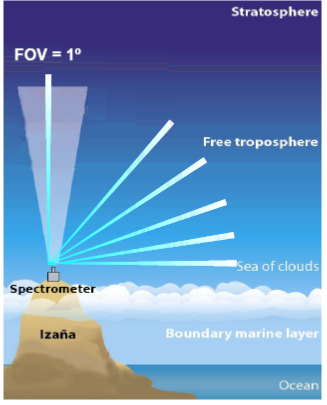New article in Atmospheric Measurement Techniques: Long-path averaged mixing ratios of O3 and NO2 in the free troposphere from mountain MAX-DOAS

A new method, named Modified Geometrical Approach (MGA), was developed to obtain surface mixing ratios of O3 and NO2 trace gases in the free troposphere using the Multi Axis Differential Optical Absorption Spectroscopy (MAX-DOAS) technique. MGA uses horizontal and near-zenith geometries to estimate the station level differential path. The main advantage of the MGA methods is that they provide mixing ratios that are barely affected by the up-welling of air masses from the boundary layer driven by valley-to-mountain breezes, as in-situ measurement techniques are. MAX-DOAS integrate optical paths over few tens of km. Therefore, unlike in situ data, MAX-DOAS measurements are representative of the free troposphere. Furthermore, MGA methods provide a simple way to estimate O3 mixing ratios when no in situ instruments are available. In fact, for NO2 it constitutes the only way to monitor concentrations of few tens of ppt, which are below the detection limit of the standard instrumentation based on chemiluminiscence. This method has been applied and validated at the Izaña Atmospheric Observatory. The NO2 validation has been performed in free troposphere conditions for the first time.

MAX-DOAS measurement scheme at Izaña.
This new method has been published in Atmospheric Measurement Techniques. The paper has been led by Laura Gomez, from the Atmospheric and instrumentation branch at the National Institute for Aerospace Technology from Spain (INTA).
The full reference of the paper is:
Gomez, L., Navarro-Comas, M., Puentedura, O., Gonzalez, Y., Cuevas, E., and Gil-Ojeda, M.: Long-path averaged mixing ratios of O3 and NO2 in the free troposphere from mountain MAX-DOAS, Atmos. Meas. Tech. Discuss., 6, 8235-8267, doi:10.5194/amtd-6-8235-2013, 2013.
The paper can be downloaded here.







